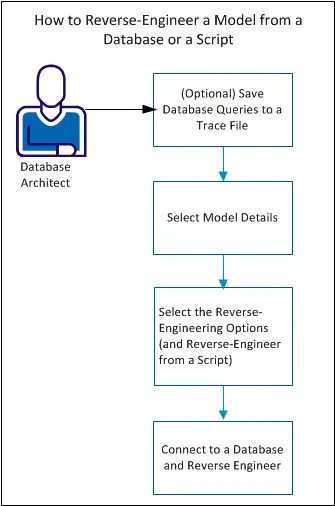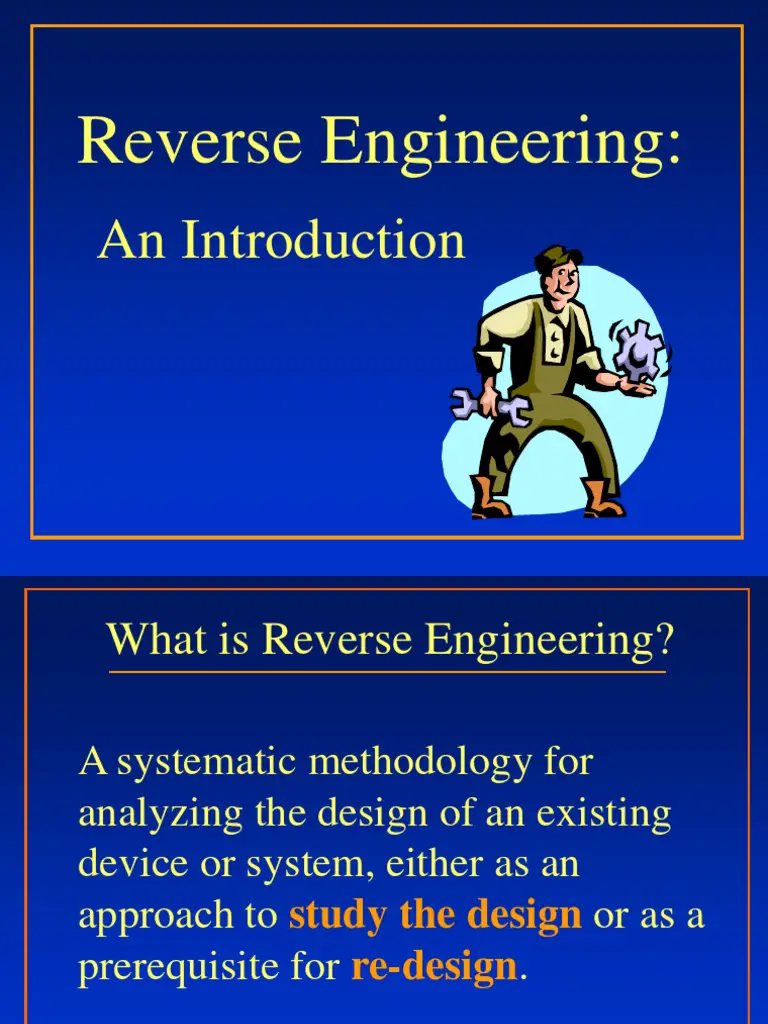Reverse Engineering and the Enhancement of User Experience

Reverse engineering is the process of extracting knowledge or design information from anything man-made and replicating it or improving upon it. In the context of user experience (UX), reverse engineering can be used to understand and improve the UX of a product or service by examining its existing features and interactions.

Benefits of Reverse Engineering for UX

There are several benefits to using reverse engineering to enhance UX:
-
Identification of pain points: By carefully examining a product or service, UX researchers can identify areas where users are experiencing pain points or frustrations. This information can then be used to make improvements that address these issues and enhance the overall user experience.
-
Benchmarking against competitors: Reverse engineering can also be used to benchmark a product or service against its competitors. This can help UX researchers identify areas where the product or service falls short and make improvements to stay ahead of the competition.
-
Inspiration for new ideas: Sometimes, the best way to come up with new ideas for improving UX is to look at what others have done. Reverse engineering can provide UX researchers with inspiration for new features, interactions, and design elements that they might not have otherwise considered.
Process of Reverse Engineering for UX
The process of reverse engineering for UX typically involves the following steps:
- Gather data: The first step is to gather as much data as possible about the product or service being studied. This includes things like user feedback, usage data, and competitive analysis.
- Analyze data: Once the data has been gathered, it is important to analyze it carefully to identify patterns and trends. This can help UX researchers identify areas where the UX can be improved.
- Create a model: The next step is to create a model of the product or service. This model can be used to understand how the product or service works and how users interact with it.
- Identify pain points: Once the model has been created, UX researchers can use it to identify pain points or areas where users are experiencing frustrations.
- Generate insights: The final step is to generate insights from the data and the model. These insights can be used to make improvements to the UX of the product or service.
Conclusion
Reverse engineering can be a powerful tool for enhancing UX. By carefully examining a product or service, UX researchers can identify pain points, benchmark against competitors, and generate inspiration for new ideas. This information can then be used to make improvements that address these issues and enhance the overall user experience.# Reverse Engineering And The Enhancement Of User Experience
Executive Summary
Reverse engineering is an innovative method that involves examining a system, in this context, a website or software application, to understand its structure, functionality, and inner workings. By unraveling the components and relationships within the system, we can derive valuable insights into its design and performance. This knowledge empowers us to replicate, improve upon, or adapt the system to better serve our unique needs and objectives.
Introduction
Today’s digital landscape is fiercely competitive, demanding websites and applications that deliver exceptional user experiences. To stay ahead of the curve, organizations need to constantly innovate and refine their products and services. Reverse engineering provides a powerful means to analyze and learn from successful competitors, industry leaders, and even emerging startups. By dissecting their strengths, weaknesses, and key design elements, we can extract valuable lessons and incorporate them into our own products, leading to improved user engagement, satisfaction, and ultimately, increased conversion rates.
1. Understanding User Needs and Preferences
The cornerstone of a successful user experience lies in comprehending user needs, preferences, and pain points. Reverse engineering competitors’ websites and applications offers a goldmine of data on user behavior, interaction patterns, and preferences.
-
Analyze User Engagement Metrics: By delving into metrics such as time on site, bounce rates, and conversion rates, we can gauge how users interact with various elements of a website or application. This analysis helps identify areas that need improvement and opportunities for enhancing engagement.
-
Conduct User Surveys and Interviews: Engaging directly with users through surveys and interviews provides invaluable insights into their needs and expectations. Gathering feedback on their likes, dislikes, and pain points enables us to make data-driven decisions and tailor our products accordingly.
-
Study User Reviews and Feedback: User reviews and feedback, often found on platforms like app stores and social media, offer a wealth of information about user sentiment and satisfaction levels. Analyzing these reviews can help us identify common user concerns and opportunities for improvement.
2. Identifying Best Practices and Trends
Keeping abreast of industry trends and best practices is crucial for staying competitive and delivering cutting-edge user experiences. Reverse engineering allows us to uncover innovative design patterns, technological advancements, and marketing strategies employed by our competitors and thought leaders.
-
Analyze Design Patterns and UI Elements: Scrutinizing the design patterns, user interface elements, and layouts adopted by successful products can inspire fresh ideas and approaches to improving the overall look, feel, and usability of our products.
-
Research New Technologies and Features: By staying updated with emerging technologies and trending features, we can incorporate these advancements into our products, staying ahead of the curve and providing users with a modern and innovative experience.
-
Follow Industry Blogs and Publications: Industry blogs, publications, and thought leadership articles offer valuable insights into current trends, best practices, and challenges faced by the industry. Staying informed helps us adapt to changing dynamics and stay relevant to our users.
3. Detecting Vulnerabilities and Security Risks
In the digital age, security is paramount. Reverse engineering can help us identify vulnerabilities and potential security risks in our own products by examining competitors’ systems and learning from their mistakes.
-
Analyze Security Measures: By carefully scrutinizing competitors’ security measures, we can identify gaps and weaknesses in our own security infrastructure. This knowledge enables us to implement robust security measures, protecting user data and maintaining trust.
-
Conduct Penetration Testing: Penetration testing simulates real-world attacks to uncover vulnerabilities and assess the overall security posture of a system. Conducting penetration tests on our products and competitors’ products can help us identify and address potential vulnerabilities before they are exploited by malicious actors.
-
Stay Updated on Security News and Advisories: Proactively staying informed about the latest security threats, vulnerabilities, and security patches helps us remain vigilant and adapt our security measures accordingly.
4. Gaining Inspiration for New Features and Functionality
Reverse engineering competitors’ products can spark creativity and inspire ideas for new features, functionalities, and enhancements to our own products.
-
Study Advanced Features: Analyzing advanced features and functionalities offered by competitors can inspire innovative ideas and help us differentiate our products in the market.
-
Identify Gaps and Opportunities: By identifying areas where competitors’ products fall short, we can leverage these gaps to develop new features that address unmet user needs and provide a competitive advantage.
-
Benchmark Against Industry Leaders: Benchmarking our products against industry leaders helps us identify areas where we can improve and incorporate best practices to deliver a superior user experience.
5. Evaluating the Effectiveness of Marketing and Promotion Strategies
Understanding the marketing and promotion strategies employed by competitors is crucial for staying competitive and reaching our target audience effectively.
-
Analyze Marketing Channels and Tactics: By studying competitors’ marketing channels, messaging, and promotional tactics, we can gain insights into what strategies resonate with their audience. This knowledge helps us fine-tune our marketing campaigns and reach our target audience more effectively.
-
Monitor Social Media Presence: Social media platforms provide a window into competitors’ brand image, engagement levels, and customer interactions. Monitoring their social media activities helps us understand their strengths, weaknesses, and opportunities for improvement.
-
Track Advertising Campaigns: Analyzing competitors’ advertising campaigns, including their ad copy, targeting strategies, and landing pages, can provide valuable insights into effective marketing practices. This knowledge helps us optimize our advertising efforts for better results.
Conclusion
Reverse engineering competitors’ products offers a wealth of opportunities to enhance user experience by uncovering valuable insights into their strengths, weaknesses, best practices, and industry trends. By conducting thorough analysis, we can identify areas for improvement, gain inspiration for new features, identify security vulnerabilities, and stay competitive in the ever-changing digital landscape. Reverse engineering is an essential tool for organizations seeking to deliver exceptional user experiences and achieve lasting success in the digital realm.
Keyword Phrase Tags:
- Reverse Engineering
- User Experience
- Competitor Analysis
- Innovation
- Product Development

Good read!
This is just a rehash of old ideas. There’s nothing new here.
Reverse engineering can also be used to identify security vulnerabilities in software. This can help to protect users from hackers and other malicious actors.
I disagree with the author’s claim that reverse engineering is always a good thing. In some cases, it can be used to create harmful products or to steal intellectual property.
The author seems to be implying that reverse engineering is only used by criminals and hackers. This is not true. Many legitimate businesses use reverse engineering to improve their products and services.
I’m not sure I understand the point of this article. Reverse engineering is a well-known technique that has been used for centuries. What’s new here?
This is a great article! I’ve always been interested in reverse engineering, but I never knew how it could be used to improve user experience. I’m definitely going to try some of these techniques in my own work.
I’m not sure I agree with the author’s claim that reverse engineering is always a good thing. In some cases, it can be used to create harmful products or to steal intellectual property.
This is a great article! I’ve always been interested in reverse engineering, but I never knew how it could be used to improve user experience. I’m definitely going to try some of these techniques in my own work.
The author seems to be implying that reverse engineering is only used by criminals and hackers. This is not true. Many legitimate businesses use reverse engineering to improve their products and services.
I’m not sure I understand the point of this article. Reverse engineering is a well-known technique that has been used for centuries. What’s new here?